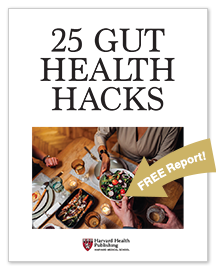What is essential tremor?
On call

Q. I think I have essential tremor, but I worry that it might be early Parkinson’s disease. How can you tell the difference? What helps calm the shaking?
A. Essential tremor is when one or more body parts shake involuntarily without another diagnosable cause. It usually begins in a person’s 40s and gradually becomes more troublesome over the following decades.
The shakiness is often called an intention or action tremor because it worsens when a person performs a specific task, such as picking up a glass. The most common initial symptom is shaking of the hands, but other areas, including the arms, legs, and head, are frequently involved. Some people develop a trembling voice. At rest or during sleep, the tremor tends to improve or go away.
A leading theory suggests that essential tremor originates in the cerebellum (the part of the brain that controls movement and balance) or its connections with the brainstem, which lies at the base of the brain. The condition often runs in families. If you have essential tremor, your children will have a 50% chance of developing it.
People often get concerned that the trembling is a sign of Parkinson’s disease rather than essential tremor. But there are classic differences. With essential tremor, the involuntary shaking increases when you move and try to use your hands. In Parkinson’s disease, tremors occur mainly at rest, and activity reduces the shaking.
Some people with essential tremor develop head nodding or shaking; few people with Parkinson’s do. Balance problems and rigidity of the arms and legs are common features of Parkinson’s disease, but not of essential tremor.
No treatment is needed for mild symptoms of essential tremor. Avoiding caffeine and stress, and getting plenty of rest can be helpful. In social situations, slowly consuming one alcoholic beverage can reduce tremors. (That’s another difference from the tremor of Parkinson’s tremor, which does not improve by drinking alcohol.)
However, for symptoms of essential tremor that impair quality of life, most doctors prescribe either a beta blocker, usually propranolol (Inderal LA), or primidone (Mysoline), an antiseizure medicine.
If the initial choice doesn’t work, you can try the other, and sometimes taking both helps the most. Alternative medications include the antiseizure drugs topiramate (Trokendi XR) and gabapentin (Horizant).
Image: © RealPeopleGroup/Getty Images
About the Author

Howard E. LeWine, MD, Chief Medical Editor, Harvard Health Publishing; Editorial Advisory Board Member, Harvard Health Publishing
Disclaimer:
As a service to our readers, Harvard Health Publishing provides access to our library of archived content. Please note the date of last review or update on all articles.
No content on this site, regardless of date, should ever be used as a substitute for direct medical advice from your doctor or other qualified clinician.
















